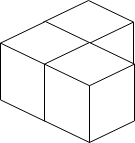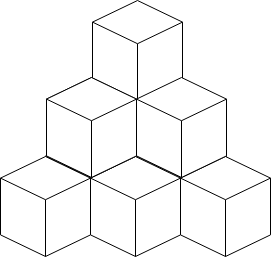| comments | difficulty | edit_url | rating | source | tags | |||
|---|---|---|---|---|---|---|---|---|
true |
Hard |
2198 |
Weekly Contest 225 Q4 |
|
You have a cubic storeroom where the width, length, and height of the room are all equal to n units. You are asked to place n boxes in this room where each box is a cube of unit side length. There are however some rules to placing the boxes:
- You can place the boxes anywhere on the floor.
- If box
xis placed on top of the boxy, then each side of the four vertical sides of the boxymust either be adjacent to another box or to a wall.
Given an integer n, return the minimum possible number of boxes touching the floor.
Example 1:
Input: n = 3 Output: 3 Explanation: The figure above is for the placement of the three boxes. These boxes are placed in the corner of the room, where the corner is on the left side.
Example 2:
Input: n = 4 Output: 3 Explanation: The figure above is for the placement of the four boxes. These boxes are placed in the corner of the room, where the corner is on the left side.
Example 3:
Input: n = 10 Output: 6 Explanation: The figure above is for the placement of the ten boxes. These boxes are placed in the corner of the room, where the corner is on the back side.
Constraints:
1 <= n <= 109
According to the problem description, the box with the highest number of layers needs to be placed in the corner of the wall, and the arrangement of the boxes is in a step-like shape, which can minimize the number of boxes touching the ground.
Assume that the boxes are arranged in
If there are still remaining boxes at this point, they can continue to be placed from the lowest layer. Assume that
The time complexity is
class Solution:
def minimumBoxes(self, n: int) -> int:
s, k = 0, 1
while s + k * (k + 1) // 2 <= n:
s += k * (k + 1) // 2
k += 1
k -= 1
ans = k * (k + 1) // 2
k = 1
while s < n:
ans += 1
s += k
k += 1
return ansclass Solution {
public int minimumBoxes(int n) {
int s = 0, k = 1;
while (s + k * (k + 1) / 2 <= n) {
s += k * (k + 1) / 2;
++k;
}
--k;
int ans = k * (k + 1) / 2;
k = 1;
while (s < n) {
++ans;
s += k;
++k;
}
return ans;
}
}class Solution {
public:
int minimumBoxes(int n) {
int s = 0, k = 1;
while (s + k * (k + 1) / 2 <= n) {
s += k * (k + 1) / 2;
++k;
}
--k;
int ans = k * (k + 1) / 2;
k = 1;
while (s < n) {
++ans;
s += k;
++k;
}
return ans;
}
};func minimumBoxes(n int) int {
s, k := 0, 1
for s+k*(k+1)/2 <= n {
s += k * (k + 1) / 2
k++
}
k--
ans := k * (k + 1) / 2
k = 1
for s < n {
ans++
s += k
k++
}
return ans
}

